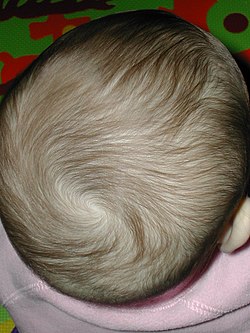Hair whorl
| Hair whorl | |
|---|---|

Human baby hair whorl
|
|
| Details | |
| Identifiers | |
| Latin | vortices pilorum |
| TA | A16.0.00.026 |
| FMA | 76564 |
|
Anatomical terminology
[]
|
|
A hair whorl is a patch of hair in a circular direction around a visible center point. Hair whorls occur in most hairy animals, on the body as well as on the head. Hair whorls, also known as crowns, swirls, trichoglyphs, or cowlicks, can be either clockwise or counterclockwise in direction of growth.
Hair whorls on the head ( whorls) have been studied by some behaviorists. Most people have clockwise scalp hair-whorls. Parietal whorls which are considered to be normal scalp patterns could be a single whorl or double whorls. Cases of triple parietal whorls are less common but do not necessarily indicate abnormality.
Amar J. S. Klar conducted research to see if there was a genetic link between handedness and hair-whorl direction. He found that 8.4% of right-handed people and 45% of left-handed people have counterclockwise hair-whorls. His research suggested that a single gene may control both handedness and hair-whorl direction. However, Klar's research methodology in this and other studies has been questioned.
Another result concerning handedness of the progeny of discordant monozygotic twins suggests that lefties are one gene apart from righties. Together, these results suggest (1) that a single gene controls handedness, whorl orientation, and twin concordance and discordance and (2) that neuronal and visceral (internal organs) forms of bilateral asymmetry are coded by separate sets of genetic pathways.
There are many (mostly apocryphal) theories concerning horse behavior and their hair whorls.
One paper has suggested that abnormal hair whorls can be used to assess the likelihood of agitated behavior or temperament in cattle in the auction ring.
...
Wikipedia
